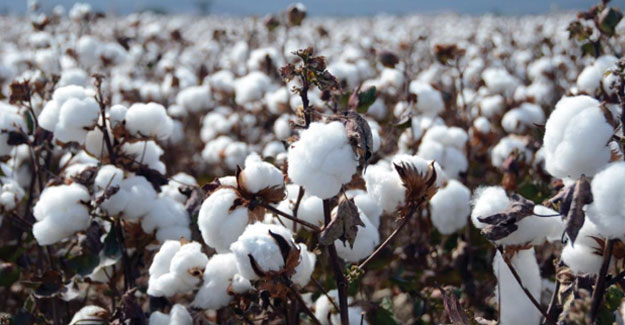
US Cotton Acreage Poised To Gain Ground
Despite a long, drawn out harvest for many Southern Plains cotton growers in the US, this winter, yields and prices have been good enough to convince many farmers at the northern edge of the cotton belt to continue increasing acreage in 2019. "The bottomline is it's making growers a lot of money, and that's the reason people are going to it," said Rex Friesen, an agronomist and public relations manager with Southern Kansas Cotton Growers Cooperative based at Anthony. "I tell people who are interested it's expensive, it's risky, it's higher management, but in the end it's been paying out way better than anything else the last several years." Seth Byrd, Oklahoma State University's statewide cotton specialist, confirmed he is hearing a similar sentiment expressed by many growers. "We could have had a better year in some respects, but at end of the day, the feedback I'm getting right now is that cotton is looking like the best thing for a lot of them," he said. In Oklahoma alone, wheat lost an estimated 400,000 acres to cotton the past two years, a trend that seems likely to continue in 2019, especially since wet weather this fall made it difficult to get winter crops planted. Pre-season surveys conducted by the cotton industry show Kansas and Oklahoma farmers are preparing to plant more cotton, with Oklahoma growers alone expected to exceed 825,000 acres, which could make for the largest planted acreage of cotton in state history. Kansas acreage is projected to top 200,000 acres. For now, though, many growers are still waiting to wrap up the current season, after wet fields and processing delays pushed harvest back later than normal across the region, Friesen said. "We normally finish harvest before Christmas and then ginning goes on into January," he said. "Because of the size of the crop last year we didn't finish ginning until mid-April and now this year it's going to be even later than that." Most of the Kansas crop has finally been harvested, but many growers are still waiting on the gins to analyse the quality, which will determine the ultimate price they receive. "If they can hang on and be patient, I think they'll be very happy with how it turns out," Friesen said. The biggest discount farmers are likely to see this fall will be due to off-colouring, Friesen said. "Due to all the rain, the fibre is not going to be the consistent brilliant white that we've grown accustomed to seeing in this area," he explained. Cotton is graded on six factors, which include colour, fibre strength, fibre length (or staple), maturity (or micronnaire), uniformity and leaf content (or contaminate level.) "Fibre maturity and quality has been fine to excellent, and some farmers have even been getting a premium for that," Friesen said. "But any one of these quality factors can affect the price significantly." Meanwhile, infrastructure in the region is still struggling to catch up to the surge of new demand. Expansion and construction delays at five gins across southern Kansas have pushed back processing wait-times. "This is the year of growing pains, but next year it should be a lot better," Friesen said. Individual farmers have also been buying baler-harvesters at a fast clip. Friesen estimated at least three-dozen of the US$ 800,000 machines have been purchased new or used around the state, with others coming on line in northern Oklahoma. Trent Milacek, the northwest area agricultural economist for Oklahoma State University, has been helping farmers run the numbers as they decide which crops to plant in 2019. "When you take into account the yields farmers have seen on cotton the last two or three years, with averages of around 800 pounds per acre, it looks like a pretty good opportunity to make some money," he said. Using conservative figures he said farmers in the area could expect to make close to US$ 400 per acre gross revenue from the sale of lint and cottonseed combined. For that reason, cotton is on the upswing while interest in other crops is fading. Cotton farmers finish season with next hurdle to sell product amid trade dispute Many South Plains gins are cleaning up the last of their modules as ginning season comes to an end, but the work to sell the cotton that was processed is slow-going due to unresolved trade talks. "As cotton producers, we are an export market and what we rely on is having a home for this cotton," Kris Verett of Verett Farms said. "We need foreign markets for that to go to and that's kind of what's driving the uncertainty in the market." The implementation and threat of trade tariffs between the United States and China rocked the market, according to Verett and Butman. The 35-day government shutdown also prevented producers from obtaining needed loans. "They announced the tariffs and that really put things into a tailspin," Butman said. "We lost 10 cents per pound in about two weeks. It was really about three or four days but it really hasn't rebounded much since then." Chinese retaliation on the United States for the tariffs is what is suspected of causing the lack of demand, keeping South Plains cotton stuck in warehouses. "I would say if you had your cotton marketed before this, it was at least a lot more stable and had some place for it to go," Verett said. "What we do have left is kind of in limbo with uncertainty as to what the cotton market is going to do. The hope is the market will come back up."
Textile Excellence
If you wish to Subscribe to Textile Excellence Print Edition, kindly fill in the below form and we shall get back to you with details.








